DOES THE WORD “CHANGE” make you shiver in dread or in anticipation? No matter what the prospect of change does to your psyche, it just may be do or die in this retail environment.
But fear not. Retail jewelers who have made game-changing decisions for their businesses say they knew they had to change to thrive, or even to survive, and those decisions turned out to be positive ones.
Change feels risky, but people who want to avoid risk don’t run businesses, says jewelry-business consultant Andrea Hill. “Being an entrepreneur or a business owner is inherently risky, and the biggest risk of all is to become irrelevant,” she says. “It is always time to change. Because any business that is operating today the same way it was a year ago, five years ago, or (God forbid) 10 years ago has already fallen woefully behind.”
Hill worked with Steve and Melissa Quick of Chicago, who ultimately decided to consolidate their three Steve Quick Jewelry stores into one, even though it marked a 180-degree turn from their established business plan.
The soul searching is less about contemplating any given change, and more about contemplating who you want to be, how you want to work, and what you want to accomplish, Hill says. “In this regard, Steve and Melissa are excellent role models for the industry. They embrace change. They pursue excellence. If they try something and it doesn’t work, they don’t sit around waiting for it to change. And they don’t beat themselves up or waste precious time worrying that it was a mistake. They clearly understand that being entrepreneurs is about taking risks, and that the number of one’s successes in business will always be a fraction of the number of one’s failures. Want more successes? Risk more failures.”
Here are six case studies of jewelry owners who have taken calculated risks that transformed their businesses.

MELISSA & STEVE QUICK
FULL RESET
Steve Quick Jewelry, Chicago
Steve and Melissa Quick had a strategic plan when they added a second and third location in Chicago in 2007 and 2008. Their business, founded in 1986, had already carved out an important niche in their marketplace, specializing in the work of designers and artists not found anywhere else in the metro area.
But they had a wider vision. The financial plan they’d devised just prior to the Great Recession was to build the business to a small chain of five or six stores and then consider selling what they had built.
And yet, 10 years later, when they consulted with Andrea Hill (initially about staff issues), everything had changed. For one thing, they realized that post-2008, someone was unlikely to come in and buy a small chain of jewelry stores, no matter how unique.
“We initially started talking to her because we were running into a lot of staffing issues and we were looking for her help with hiring, and we were also looking for her help on how to deal with how to have three stores,” Melissa says. “The systems we had in place in one store didn’t translate to three.”
As they continued discussions with Hill, the conversation started moving in a very different direction. “We felt we had lost our mojo with three stores. We realized our message and our story had gotten really watered down. Steve and I didn’t have enough face time with people. We started talking about going back to our roots and asking ourselves what was it that made us special? Why were we the IT store to go to in Chicago?”
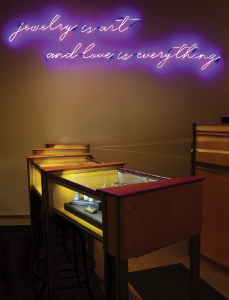
They concluded it was the experience they offered, the storytelling inherent in their distinctive merchandise, and just being different. “The word that kept coming up was authenticity,” Melissa says. “You have to be able to stand across the counter from someone and tell them why you think this piece of jewelry is special. I need to tell other people’s stories as well as our own, and if I don’t believe in their stories or their stories don’t connect with me, it doesn’t feel authentic.”
So, still somewhat surprised at the direction in which they were headed, they decided to consolidate. “It’s a very hard decision when having three stores is part of your master plan. But being bigger wasn’t making us happy; it wasn’t what made us tick. We watered down so much that we realized we’d be better, stronger, leaner by having it all in one store.”
Because the decision had been percolating for a while, as they lost team members through attrition, they didn’t replace them, taking on extra shifts themselves to fill the gap. So in October 2018 when they announced to the staff they were consolidating, they were also able to tell them they would all keep their jobs. “We closed two viable stores that were outperforming the national average,” Melissa says. “It was really important that our staff knew we weren’t failing, we just needed to change the course.”
For Melissa and Steve Quick, 2020 represents a chance to breathe again and to concentrate on e-commerce as their newest second store.
Melissa recently overheard a couple talking about the change. “Someone walked in who hadn’t been in in a while,” she recalls. “The wife said to the husband, ‘I don’t remember this store being this cool,’ and the husband said, ‘They have so much more jewelry than they used to.’ It validated everything we’d been going through the past two years. Now we need to get the word out that we are bigger and better than ever.”
Advertisement
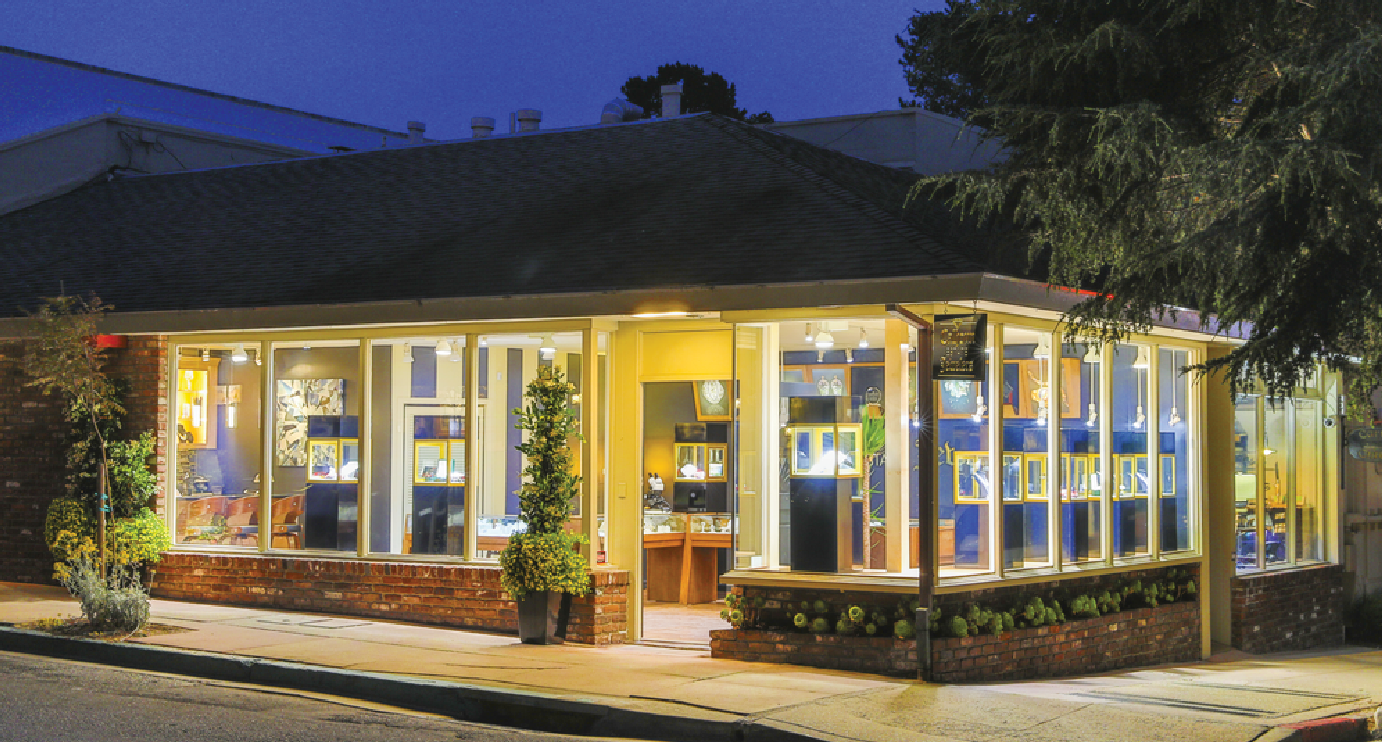
CALIFORNIA DREAMIN’
Calhoun Estate Jewelers, Carmel, CA
Cathy Calhoun, who owns Calhoun Jewelers in Royersford, PA, says she opened a second store in Carmel-by-the-Sea, CA, last year, because, in her words, “I’m out of my mind.” But there were other reasons, too, most of which revolve around a love of the location and a desire to mold her business to fit her lifestyle.
“I came to California a lot anyway,” she says. “And it was on my bucket list. I always wanted to have a store in downtown Carmel. Finally, a friend said, ‘I’m going to close my store in Carmel, unless you want to take it.’”
The time was right. She took the leap and called her second store Calhoun Estate Jewelers, stocking it with merchandise she already had stockpiled back east.
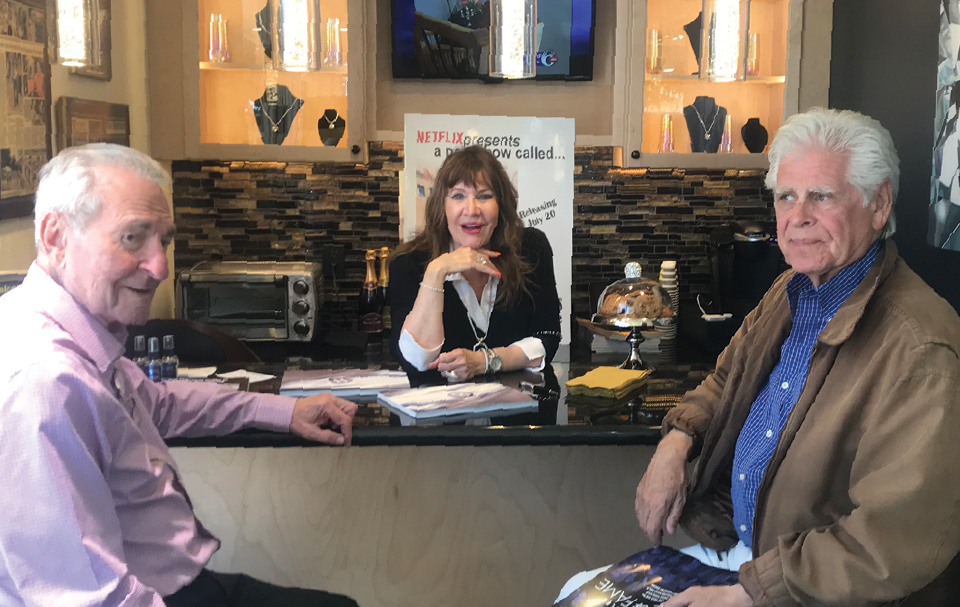
Cathy Calhoun has found a second home for herself and her retail jewelry business in Carmel-by-the-Sea, CA. She gutted the space and added a bar.
She bought the cases and contents and thought she wouldn’t change much, but once she got into the space, she decided to gut it entirely, buy custom cases from Grice Showcase, and add a cozy bar. “Everybody in the area loves it; they watched me renovate and it’s a big transformation.”
Carmel has 32 jewelry stores, 105 art galleries and 31 wine bars. During the summer tourist season, thousands of people traverse the streets every day.
“I don’t know what I expected, but I thought I’d see locals in the summer,” Calhoun says. “But I had the tourists during the summer, and all the local people who live here come in the winter. Every night there’s something going on. Small dinner parties, restaurants; people are out and they’re very active.”
In this store, estate is the specialty, with big diamonds and big-ticket items the norm. “I sold an 8.50-carat recently, an old European cushion cut,” she says.
Now that she spends half of her time in Carmel, the charm of the town still hasn’t worn off. “When I step out the front door, I look down the street and there’s the Pacific Ocean. Your door is always open; you don’t close the door. People wander in with their pets.”
“I am having fun and it’s so beautiful out here,” she says. “I have a great house in Carmel Valley at the very top of the mountain, and I can see the ocean. I’m above the clouds. I’m so lucky to be here.”

GORDON & DEBORAH EID
BYE BYE MALL
EIDOS Contemporary Jewelry, Santa Fe, NM
Gordon and Deborah Eid’s store, EIDOS Contemporary Jewelry, was part of a collection of 18 stores known as Sanbusco Market that were housed in a repurposed 19th century building in Santa Fe, a former timber store near the rail yard. Although it wasn’t a typical mall, it still faced the problems many malls are experiencing. First, the Borders bookstore closed, then the whole mall went into receivership in 2008, leaving the tenants in limbo. Ultimately, Wells Fargo repossessed it, and it was bought at auction by a school for the arts.
Fortunately, a year before Gordon and Deborah received notice to move out, they had seen the writing on the wall and bought a small semi-derelict building about 300 yards from the mall. They completely rebuilt the 1,000 square-foot 19th century house and built another building next to it. So while many of the other tenants decided to move into another nearby mall — also on a decline — the couple moved their business into their own space and converted it again from a house to a jewelry gallery with room enough for a workshop.
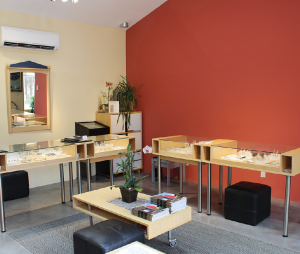
“We went from a 550-square-foot place in the mall into a 1,050-square-foot building,” Gordon says. “We probably get less foot traffic here, but it means we can work on our own work when not serving customers.”
Because they can set their own hours now, they no longer have a staff. “The biggest improvement to our lives is we are not having our hours dictated to us by someone else,” Gordon says. “In the mall, if we closed outside normal closing hours, we got fined, and the mall was only closed four days a year.” They also had no choice but to stay open from 9 a.m. to 9 p.m. during the holiday season.
Now they’re closed on Sundays for the first time in 15 years, and they also close on Mondays during the winter. “And if we want to go to Tucson for the gem shows, which we do, we just close,” Gordon says. The area itself is growing, too, with an REI, a movie theater and a tea house in close proximity.
Overall, the change has been positive and fits with the evolving retail landscape. Says Gordon: “I’ve been doing this for 50 years, and the retail market has changed more radically in five years than in the past 45 years. I’d like to claim being clever, but I will settle for lucky.”
Advertisement
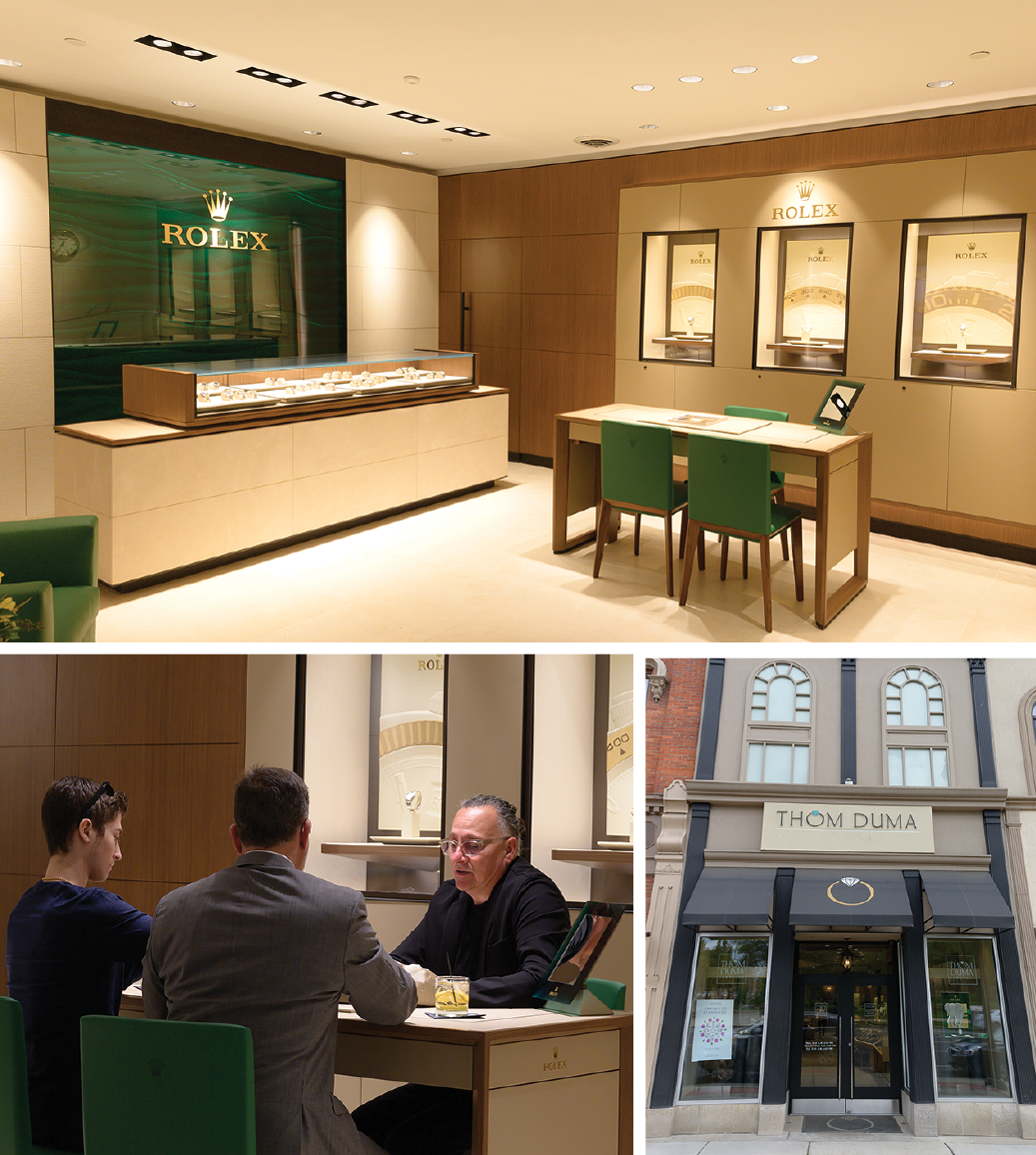
Tom Duma found space for a branded Rolex boutique, which enhances his business.
POWERED BY BRANDS
Thom Duma Fine Jewelers, Warren, OH
After years of being confined to an 18-foot-wide by 100-foot-long space, Tom Duma was thrilled to be able to acquire some adjacent space and add a 500-square-foot Rolex boutique to his store last year, an addition that fits with his master plan to carry top-of-the-line brands in his downtown Warren, OH, store, Thom Duma Fine Jewelers.
He also seized the opportunity to update the cases and change the floor coverings, which he does every five years anyway.
Rolex is Duma’s No. 1 brand in Warren, which is about midway between Pittsburgh, PA and Cleveland, OH. While adding 500 square feet may not seem like a monumental change, it saved him from cutting into his small existing space to support a brand so important to his business.
It also was the culmination of a dramatic change he implemented in 2002 when he decided to reinvent the family business as a branded jewelry store, at a time when there were no branded jewelry stores in his market. “In 2002, I took a look at the market and said this is what I’d like to do, and with no promise from any brands and a 10-year inventory plan, I gutted the store and did a major renovation. My father thought I was crazy, rest his soul,” Duma says. “When my twin sons and I were doing the demo, he said, ‘You should just change the carpet. You don’t want to take down those walls!’”
“I didn’t have a boatload of cash,” he says. “We shut down the store in May and I was walking JCK in June with blueprints under my arm. I would go to vendors and tell everyone my dream and a few people latched onto it and believed in me and here we are. Tacori, Verragio, Mikimoto, Rolex, none of those brands existed in our marketplace.”
It was a risky move, Duma says, but he knew he had to change or perish. No one was going to drive to his store for a watch or generic piece they could buy anywhere.
“About a year after we opened, we got Rolex, and from there, we began to get every brand that we currently have. I said this is my dream, this is my vision, and by the grace of God, it all fell into place.” Now half of his business comes from within the county and the other half drive from farther afield to visit his branded destination store.
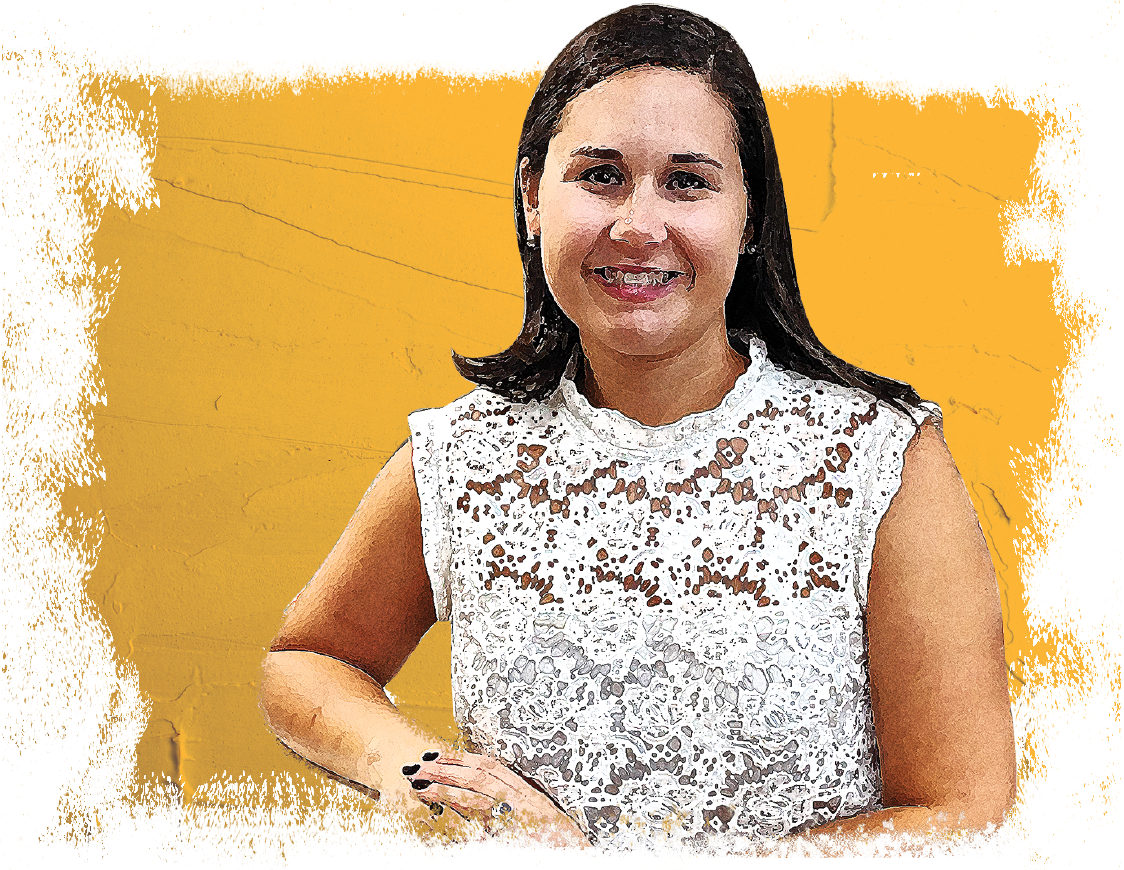
ALLISON LEITZEL-WILLIAMS
GOING FOR SECONDS
Leitzel’s Jewelry, Hershey, PA
In 2017, two years before the company’s 70th anniversary, Leitzel’s Jewelry opened a second store in Hershey, PA, called Leitzel’s Jewelry on Chocolate.
Although it was an idea that had been considered for some time, when the perfect building, a former bank, was up for grabs at an auction, they needed to move fast.
Third-generation jeweler Allison Leitzel-Williams, along with her father, Ceylon, and her husband, Trevor, decided to go for it. One reason, she says, is that there were “too many cooks in the kitchen.” Her dad was still active in the business, and they didn’t need three people running one successful store. “We came to the auction not knowing if we’d get the building or how serious we would be, but we were in the right place at the right time.”

Leitzel’s Jewelry on Chocolate, named for the street it’s on in Hershey, PA, created an opportunity for the family business to grow.
Beyond making space for the three of them to grow, the addition also helped the company and the staff to reach its fullest potential. “Our team has become like family,” Leitzel-Williams says. “It’s very encouraging to see how they have empowered themselves since we opened a second location.”
Trevor Williams, who comes from an accounting background, also brought an outside perspective that made him cognizant of the potential growth that could come from a store in Hershey, about 18 miles away from their store in Myerstown. The demographics were a little different, and average sales in Hershey are higher than in Myerstown. Leitzel-Williams says that one of the best decisions they made for the new store was to be closed on Sundays and Mondays, carving out time for family life, simplifying staff scheduling, and creating flexible time for meetings or projects as needed.
“We didn’t want to bite off more than we could chew,” she says. “And that has been a big part of our success. The staff appreciates the family time they can rely on. We had the idea we could always add another day, but it would be harder to take away a day later.”
“We’re thrilled with the results. We had a great opportunity to expand when business was good. We had the staff to accomplish it, and the desire to bring more sparkle to people’s lives!”

A major expansion leads to continued growth at Revolution Jewelry Works.
ELBOW ROOM
Revolution Jewelry Works, Colorado Springs, CO
In September 2019, Jennifer Farnes of Colorado Springs bought her building from her landlords while knocking out walls and expanding her business, Revolution Jewelry Works, from 1,200 to 4,300 square feet. Still, she had time for another priority — adding something particularly pretty to the ultra-practical expansion plans. She found a 350-pound chandelier for the new space. “I told my husband, I have to have a chandelier — the biggest, prettiest, gnarliest chandelier I can find.”
By the time of the expansion, eight people were working in a shop and showroom with a combined space of 1,200 square feet. “We were hitting each other with an elbow or a hip; nobody was even saying ‘excuse me’ anymore. The walls were closing in.”
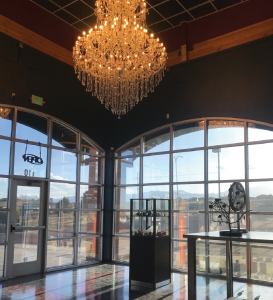
Amid rumors that her landlords wanted to sell the building, she held off as long as she could.
“I told them, ‘If you’re going to sell, I’ll buy the building,’” she says. “We outgrew our space about two years ago, and I’ve been limited on how I can hire people and where I can give them workspace. Last Christmas, we were really feeling it. Some people were shopping while others were sitting at the showcases trying to design a custom piece. I never thought we’d get that busy. But we’re making some big changes to help mitigate that with this expansion.”
Another issue was that a full closed wall between the shop and the showroom meant she and her team spent the day “shouting” at one another. The new shop occupies the space that used to be the entire combined shop and showroom. The shop and the floor are completely separated now, but still visible through glass. “The nice part is when we consult with the jewelers, clients can still see what’s happening but not necessarily hear all of the technical communication,” she says.
Farnes also used technology to facilitate communication. “We added Microsoft Surfaces for everyone in the studio so that as needed, everyone can help on the sales floor.” The store is integrating Microsoft Teams for messaging that will save trips back and forth between the shop and sales floor.
“There is a lot more elbow room, and with the extra space, we are selling a lot more out of our showcases,” she says. “I think clients feel less confined, and it puts them at ease to peruse without dancing around the team trying to help other clients.”
Farnes experienced significant continued growth, closing the year up 27 percent.

THAT VISION THING. Whatever your transition may be, be sure you have a vision before taking the leap. John P. Kotter, author of Leading Change, says that effective visions have at least these key characteristics in common: First, they describe the organization as it will be in the future. Second, they articulate a set of possibilities that are in the best interests of most people who have a stake in the situation — customers, stockholders, employees. Third, effective visions are realistic. Good visions are also clear enough to motivate action but flexible enough to allow initiative.
CREATE AN EXPERIENCE. If an expansion or renovation is the big change you’re looking to make, Tom Duma of Warren, OH, who updates his own store every five years, has this advice: “Don’t be afraid to invest,” he says, and be honest about the experience your customers are having in your store. “Retail is in the detail. It’s all about experience. Anybody can buy jewelry anywhere; it’s the experience that you have to create. Don’t be afraid to invest to create that experience, because if you don’t, then someone else is going to.”
BE PREPARED FOR ANGST. Jennifer Farnes, who expanded her Colorado business from 1,200 square feet to 4,300 square feet in 2019, suggests thinking of an expansion like a residential move. “People will get grumpy,” she says. “There will be bickering. There will be opinions. Be patient, because all of the vibes everyone has are only being shared because they care.”
BE FLEXIBLE. Farnes says if you’re moving or expanding or rearranging, don’t nail anything down as far as fixtures for the first year. Keep mobility, because until you work in the space, it’s difficult to know how well things will function with a new layout. “We are four months in and have rearranged our polishing rooms and casting room twice already.”
SHARE YOUR VISION. Change is fun, says consultant Bob Phibbs, (The Retail Doctor) but it also can make you and your staff uncomfortable. Let your team know what’s going on, but don’t let them change your vision. “You can brainstorm with the crew, but first come up with a vision and say we’ve decided we’re going for it. Ask for their input, but whether they want it or not isn’t really relevant.”
CONSIDER TECHNOLOGY. Looking to modernize your store? Consider the overall retail landscape, says Phibbs. “You don’t want to redo a store just because you’re bored with it. I start always with ‘What’s the technology you need to have in place?’ You should be able to ring someone up without counters, for example.”
GO ON A FIELD TRIP. Visit stores in Chicago or New York or LA, see how jewelers are reinventing themselves and take those ideas home, Phibbs says. “You can do a store based on you, but if it doesn’t function for the retail environment of 2020, it’s not going to work.” Take a good look at how bigger brands are lighting their stores, he says, since they have spent millions to figure that out.